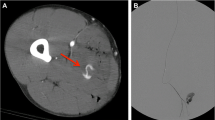Abstract
A review of angiographic studies of 227 consecutive injured patients suspected of having sustained extremity arterial trauma was done to determine whether knowledge of the mechanisms of injury was of use in the establishment of priority in multiply injured patients. Stab wounds and other lacerations occurred in 32 patients. Major arterial injury occurred in only 3 (12%) cases; in no case was arterial occlusion present or limb viability threatened. These injuries may be angiographically evaluated on a nonurgent basis. Alternatively, patients with gunshot wounds (130 patients) and blunt injuries (63 patients) had a high incidence of major arterial injury (18 and 38%, respectively), especially arterial occlusion (15 and 24%, respectively) as well as a significant incidence of threatened limb viability (5 and 21%, respectively). Disproportionately increased risk of arterial injury occurred in patients with high-energy gunshot wounds (75%), motorcycle accidents (62%), and crush injuries (63%). Patients who sustain gunshot wounds or blunt injuries and have an abnormal vascular physical examination should be evaluated angiographically on an urgent basis.
Similar content being viewed by others
References
DeBakey ME, Simeone FA (1946) Battle injuries of the arteries in World War II: An analysis of 2,471 cases. Ann Surg 123:534–579
Rich NM, Baugh JH, Hughes CW (1970) Acute arterial injuries in Vietnam: 1,000 cases. J Trauma 10:359–369
Perry MO, Thal ER, Shires GT (1971) Management of arterial injuries. Ann Surg 173:403–408
Kelly GL, Eiseman B (1975) Civilian vascular injuries. J Trauma 15:507–514
Snyder WH III, Thal ER, Bridges RA, Gerlock AJ, Perry MO, Fry WJ (1978) The validity of normal arteriography in penetrating trauma. Arch Surg 113:424–428
Rose SC, Moore EE (1987) Emergency trauma angiography: Accuracy, safety, and pitfalls. AJR 148:1243–1246
Rose SC, Moore EE (1987) Angiography in patients with arterial trauma: Correlation between angiographic abnormalities, operative findings, and clinical outcome. AJR 149:613–619
Rose SC, Moore EE (1988) Trauma angiography: The use of clinical findings to improve patients selection and case preparation. J Trauma 22:240–245
Amato JJ, Rich NM, Billy LJ, Ganber RP, Lawson NS (1971) High velocity arterial injury: A study of the mechanism of injury. J Trauma 11:412–416
Fackler ML, Malinowski JA (1985) The wound profile: A visual method for quantifying gunshot wound components. J Trauma 25:522–529
Barach E, Tomlanovich M, Nowak R (1986) Ballistics: A pathophysiologic examination of the wounding mechanisms of firearms. Part I. J Trauma 26:225–235
Barach E, Tomlanovich M, Nowak R (1986) Ballistics: A pathophysiologic examination of the wounding mechanisms of firearms. Part II. J Trauma 26:374–383
DeMuth WE Jr (1971) The mechanism of shotgun wounds. J Trauma 11:219–229
Meyer JP, Lim LT, Schuler JJ, Castronvovo JJ, Buchbindel D, Woelfez GF, Flanigan DP (1985) Peripheral vascular trauma from close-range shotgun injuries. Arch Surg 120:1126–1131
Miller HH, Welch CS (1949) Quantitative studies of the time factor in arterial injuries. Ann Surg 130:428–438
Author information
Authors and Affiliations
Rights and permissions
About this article
Cite this article
Rose, S.C., Moore, E.E. Trauma angiography of the extremity: The impact of injury mechanism on triage decisions. Cardiovasc Intervent Radiol 11, 136–139 (1988). https://doi.org/10.1007/BF02577103
Issue Date:
DOI: https://doi.org/10.1007/BF02577103




